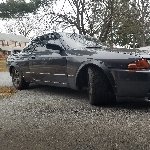R32 GTR Ecu Code 21 and 34
Announcements
-
Similar Content
-
Latest Posts
-
By joshuaho96 · Posted
I did basically the same procedure on a ZF6HP but the reason to pull the valve body is to replace the seals between the valve body and the transmission which are notorious for leaking pressure with age causing poor shifting and burning out the clutches. If you just wanted to exchange all the fluid you should be able to undo one of the transmission cooler return lines to drain into a bucket while using the pressure filler to keep it topped off. -
The title should have posted "EFR7670 exhaust housing selection RB26" I can seem to edit thr title on my Android.
-
I'm looking for some real world experiences/feed back from anyone who has personally ran a EFR7670 with a 1.05 exhaust housing or a .83 I'm leaning towards the .83 because its a street car used mostly for spirited driving in the canyons roads. I"m not looking for big numbers on paper. I want a responsive powerband that will be very linear to 8000 rpm. I dont mind if power remains somewhat flat but dont want power to drop off on top. The turbo I've purchased is a 1.05, although the mounting flange T3 vs T4 and internal vs external waste gates are different on both housings, I not concern about swapping parts or making fabrication mods to get what I want. Based on some of the research I've done with chat gpt, the 1.05 housing seems to be the way to go with slightly more lag and future proofing for more mods but recommends .83 for best response/street car setup. AI doesn't have the same emotions as real people driving a GTR so I think you guys will be able to give me better feed back 😀
-
Surely somebody has one in VIC. Have you asked at any shops? Is this the yearly inspection or did you get a canary?
-



Recommended Posts
Create an account or sign in to comment
You need to be a member in order to leave a comment
Create an account
Sign up for a new account in our community. It's easy!
Register a new accountSign in
Already have an account? Sign in here.
Sign In Now